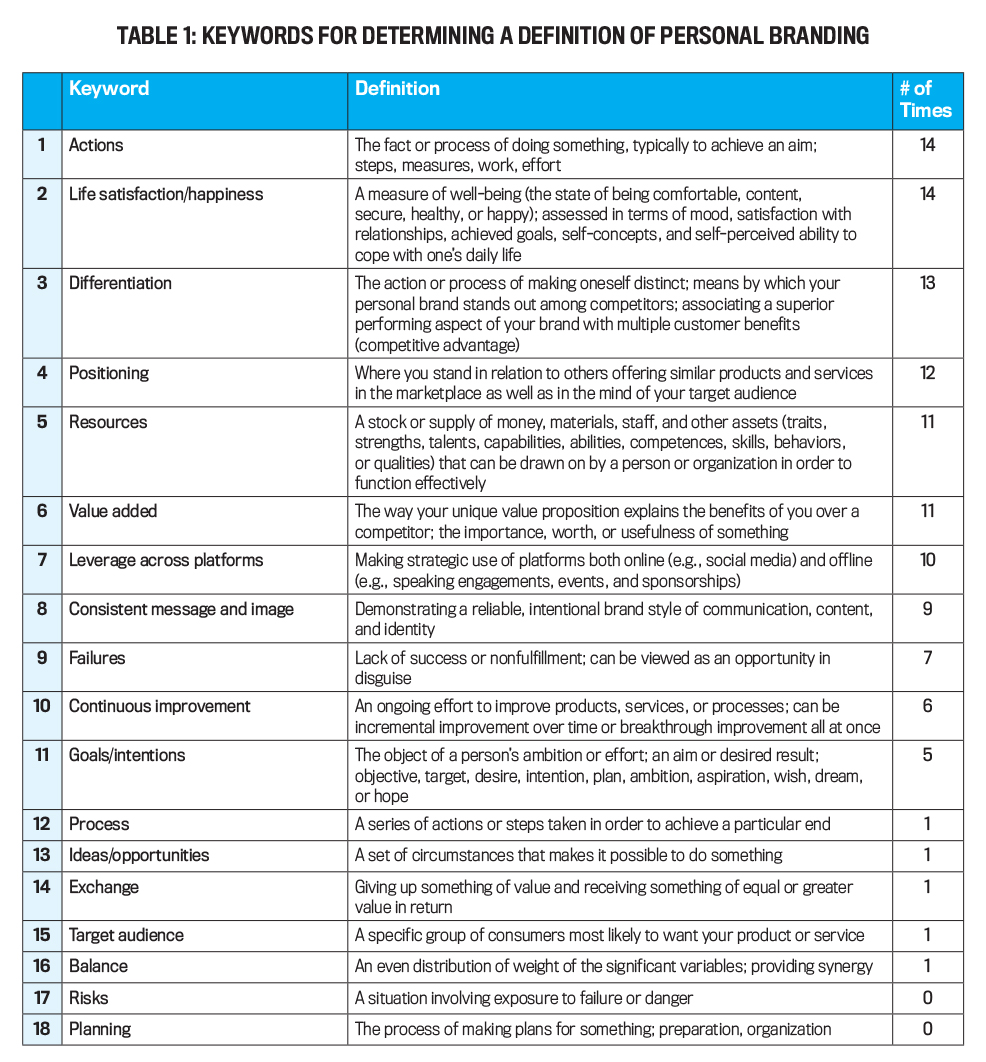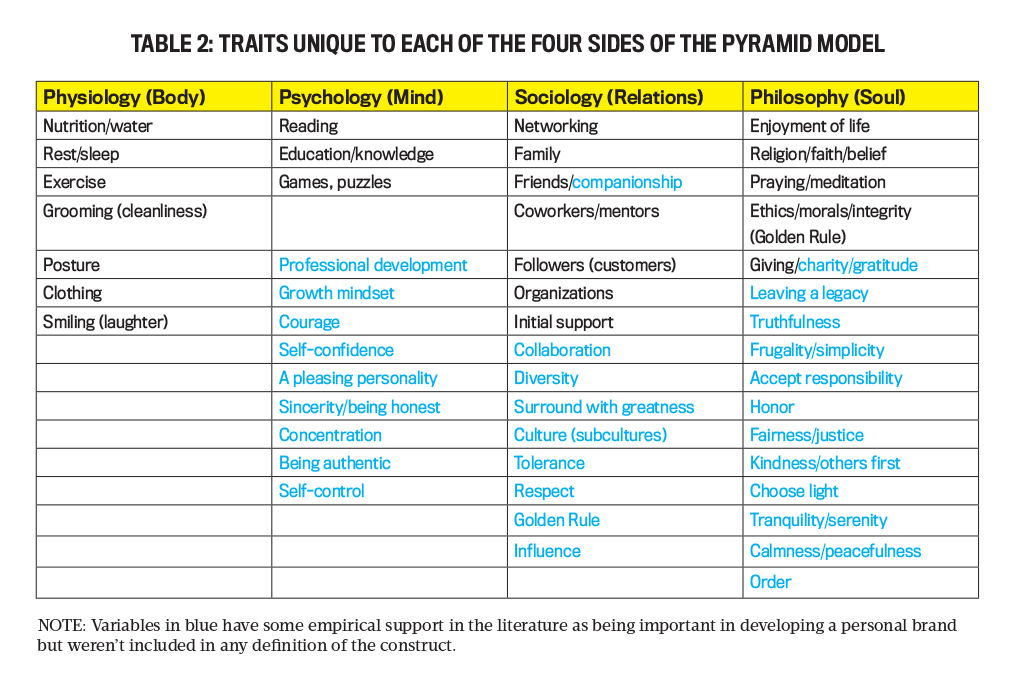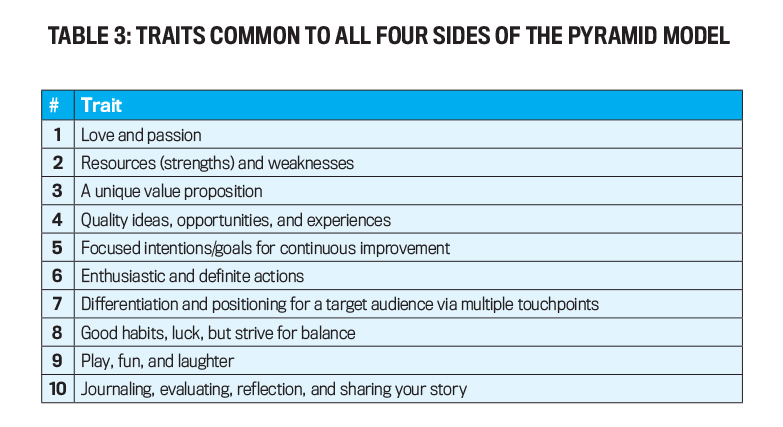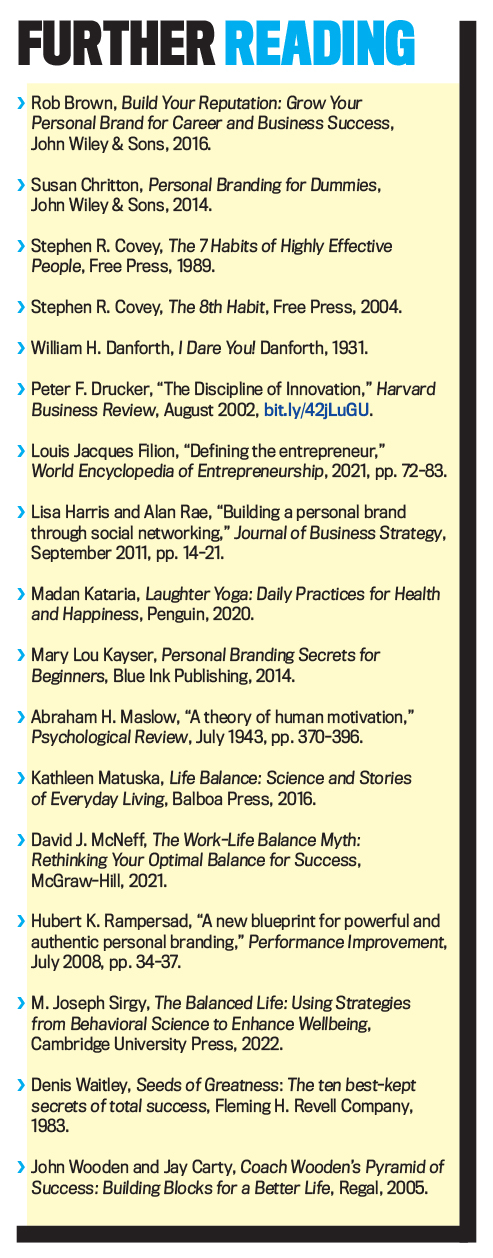Your personal brand is the impression others form when they think of you. Though it was nearly seven years ago that Reina G. Wiatt wrote in Strategic Finance about building a personal brand (“Raising the Bar,” October 2016), many scholars and practitioners now consider developing a personal brand the key to achieving success not just in one’s professional life, but in all arenas. In fact, it’s widely understood that in today’s ultracompetitive world, developing a personal brand isn’t optional.
Research has shown that accounting and finance professionals who are unreceptive or hesitant about branding themselves are missing out on great opportunities for speaking engagements, press, and enhancing their careers and personal life. Wherever you are in your career as an accounting and finance professional, you should have a personal brand—it’s no longer the purview of only celebrities, entertainers, professional athletes, and politicians.
Googling the term “personal branding” returns 655 million hits. Refining that search to make it more relevant for accounting and finance professionals, a search of “personal branding and CMA” results in more than 16.4 million hits. The 2018 video “CMA Enhances Your Personal Brand” on YouTube has more than 21,000 views.
CRUCIAL BRANDING KEYWORDS
So what exactly is a personal brand? In 2022, we widely searched online sources and produced a content analysis of keywords from more than 50 definitions of personal branding to develop a comprehensive definition.
The analysis identified 18 keywords commonly included in a definition (see Table 1). “Actions” and “life satisfaction/happiness” were the concepts most often mentioned (14 times). “Differentiation” was third (mentioned 13 times), while “positioning” was fourth (12 times). The keywords “resources” and “value added” tied for fifth (11 times), while “leverage across platforms” was seventh (10 times) and “consistent message and image” was eighth (nine times). “Failures” and “continuous improvement” round out the top 10 keywords with seven and six mentions, respectively. “Goals/intentions” placed 11th with five mentions.
While “process,” “ideas/opportunities,” “exchange,” “target audience,” and “balance” had only one mention each, we consider each of these to be crucial variables in a definition. All social sciences involve a process. Good ideas or opportunities must be recognized and seized in order to establish an effective personal brand, and resources have to be given up (exchanged) in order to obtain equal or more valuable resources. (For example, time will have to be spent on studying for the CMA® (Certified Management Accountant) exam, and money may have to be spent on courses, materials, or other professional development to enhance the likelihood of passing the exam.) You can’t have enough resources to be everything to everybody, so you must select a specific audience to target. Finally, research has found that balance is most important to personal branding.
To confirm the 18 keywords, we performed a content analysis of online research (April through July 2022) regarding the definition of personal branding. While the 39 online articles examined contained an abundance of wisdom, most weren’t based on empirical findings. Nevertheless, the scientific evidence and/or logic for 16 other variables was so compelling that they were added to the definition. These were: preparation, being able to visualize, challenging, holistic vision, focused goals/intentions, passion, enthusiasm, determination, definite actions, discipline, habits, perseverance, positive, influence, and not becoming complacent.
Knowing these variables can enable accounting and finance professionals to become proactive in creating or enhancing their own personal brand. Moreover, it becomes more manageable when these factors can be categorized into four areas as illustrated by our simple model: psychology, sociology, physiology, and philosophy (see Figure 1).
We used a pyramid because research showed that, to be successful in any endeavor, project, plan, or even one’s life, it’s necessary to balance the component parts. A pyramid could collapse if one side gets significantly out of balance. Using this model, an individual can quickly see if a side is out of balance and take steps to correct it.
LIFE BALANCE AND PERSONAL BRANDING
Life balance is the concept of managing the different segments of life with the goal of equilibrium (balance) and creating synergy (two or more life segments producing a combined effect greater than the sum of their separate effects). We conducted a content analysis on the various life balance models. Most utilized four categories, two used five, one used six, and one used seven. The results indicated that all the factors could be included in the four sides of the
pyramid model.
Now that we know that the life balance theory is important for personal branding, the next step is to determine which traits (or resources, assets, strengths, talents, capabilities, abilities, competencies, skills, behaviors, or qualities) fit into each “side” of the pyramid model.
Trait theory became a favorite technique of personal branding researchers when Napoleon Hill published The Law of Success, The Magic Ladder to Success, and Think & Grow Rich. Hill claimed his list of traits were the result of his interviewing 500 successful people and thousands of failures over a 20-year time span.
A meta-analysis performed on the various lists of traits revealed that there were a number of traits unique to each of the four sides (see Table 2) and 10 common to all four sides (see Table 3). Your personal brand is the blend of these traits in the four sides of the pyramid that make you unique.
The variables included in physiology are those related to health—getting proper nutrition, sufficient water, enough sleep or rest, and adequate exercise—and physical appearance. A successful personal brand can also be developed at any age, regardless of gender. And no other demographic feature shows any correlation.
Regarding psychology, the accounting and/or finance professional who takes advantage of formal and informal educational opportunities and professional development experiences and reads a lot is well on the way to creating a successful personal brand. Money and time spent on increasing psychological factors should be viewed as an investment because the potential payoff is substantial.
Enhancing a person’s social capital is equally as important as increasing health or mental capabilities. Successful professionals know the importance of networking, collaborating, and serving—especially as a mentor—in various professional organizations.
Finally, the ultimate goal for many successful (and happy) professionals is to enjoy life. Life satisfaction and well-being can be accomplished by meditating, giving back, being kind, showing gratitude, seeking justice, and having faith in something greater than yourself.
THE 10 COMMON TRAITS OF THE PYRAMID
Accounting and finance professionals can specifically utilize each of the 10 traits common to all four sides of the pyramid model to enhance their personal branding. Let’s take a look at each, including how the sides of the pyramid relate specifically to the traits’ unique characteristics.
1. Demonstrate love and passion. In Personal Branding for Dummies, Susan Chritton demonstrates that love, though not a part of any known definition of personal branding, is the most important resource that a person who desires to successfully brand themselves can possess. This includes an enthusiastic love for all components of the four sides of the pyramid, which incorporate your body and mind, your work, your community, and your philosophical values or virtues that you find important.
2. Inventory and evaluate resources and weaknesses. In addition to love and passion, each professional possesses a set of unique skills, talents, or resources. Every accounting and finance professional also has a unique purpose. It’s critical that you know your “current” image both online and off.
A good first step is to search for your name online. Next, evaluate your existing strengths and weaknesses (the SW of a personal SWOT analysis, or what the accountant in you might view as assets and liabilities) matching to the variables in Tables 2 and 3. Doing this will greatly assist you in creating or enhancing an authentic personal brand and turning “failures” into successes. Research shows that using money (though not a strong determinant of success), being determined, not wasting resources, and having self-control can enhance the development of an effective personal brand.
Conducting an inventory will clearly show the areas of your life that are going well, those that need attention, or those that may be outsourced. The Pareto principle (or the “80/20 rule”) often applies. Sometimes a modest improvement in a (seemingly insignificant) area of the pyramid could have a dramatic impact on your overall personal brand. For instance, improving your posture, updating your signature line for your emails, or laughing more often could create a synergistic positive effect on all four sides of the pyramid.
3. Write a unique value proposition. Once your distinguishing features have been identified and inventoried (or if you still aren’t sure, ask trusted friends to share descriptors of you), you should write a unique value proposition, mission statement, or one-sentence mantra. While your brand isn’t a tagline or a slogan, a well-defined unique value proposition can enhance your recognition as an expert; increase your reputation, credibility, and self-confidence; and advance your career. One of the authors developed a mantra (or personal brand statement) based on his four greatest strengths and uses it to guide both his professional and personal life: Work hard. Live simply. Give generously. Laugh often.
4. Recognize and seize quality ideas, opportunities, and experiences. A successfully branded professional is always on the lookout for great ideas and opportunities (the lifeblood of any personal brand) to advance his or her professional and personal life. There are five questions to ask when considering an idea or opportunity: (1) Is it needed? (2) Is it demanded? (3) Can it be priced? (4) Can you do it better than the competition? (5) Are you passionate about the idea or opportunity? Researchers agree the best ideas and opportunities are imaginative, innovative, and creative, and that your personal brand dictates your opportunities or lack thereof if you unknowingly have a weak or negative personal brand.
5. Visualize focused intentions/goals for continuous improvement. After you have determined what you want to be known for and made sure that your brand statement is cohesive, clear, and consistent, the next step is to visualize and devote resources to challenging and SMART (specific, measurable, attainable, relevant, and time-based) goals. Regarding continuous improvement (in all four sides of the pyramid), Atomic Habits author James Clear said, “If you get 1% better each day for one year, you’ll end up 37 times better by the time you’re done.” But you must be determined and dedicated and have willpower, grit, and resolve to achieve your goals or intentions.
6. Take enthusiastic and frequent actions with love. All actions have risks, and sometimes the most gigantic efforts fail. But researchers have found that people with the most failures who persevere frequently end up being the most successful. While major actions may be necessary at times, the most beneficial seem to be micro actions or achieving many small wins. All actions should center around developing a consistent look, message, and presence online and off and be performed with love.
7. Differentiate and position yourself to grow your target audience via multiple touchpoints. Once you have clarity about what makes you unique, you’re ready to distinguish your brand from the competition and position yourself as an authority in your industry to a well-defined target audience. Understanding your competitors’ unique value propositions can assist you in communicating and offering value that the competitors don’t. Use multiple touchpoints to make it easy for your target audience to choose you over the competition, to offer recommendations or endorsements, or to engage with you directly or via your online platforms.
8. Establish good habits, hope for luck, but strive for balance. Disciplined habits result from achieving goals. But the role of luck can’t be underestimated. For example, research has shown that the contribution of luck is 38% in the National Football League, but 53% in the National Hockey League.
Overall, the professional seeking to develop an authentic personal brand should endeavor to create a balance in the four sides of the pyramid. You’ll be much more successful than the lucky professional who’s below average in three of the four pyramidal areas. The Goldilocks principle certainly applies: You want all four sides of your pyramid to be “just right.”
9. Play, have fun, and laugh a lot. An often-overlooked trait that fits into all four sides of the pyramid is having a sense of humor, having fun, and laughing. Research has found that children laugh on average 300 to 400 times a day while adults laugh fewer than 30 or 40 times a day. Since researchers argue that personal branding is a journey, accounting and finance professionals should have fun along the way.
10. Keep a journal, share your story, evaluate, and reflect. Finally, life is a journey, and your personal brand will and should evolve over time. Continuous improvement in developing and growing a successful brand is enhanced by writing down your progress, successes, small wins, setbacks, or outright failures. A careful and honest evaluation and reflection can often reveal how well your brand is positively influencing your target audience’s and your own life satisfaction, well-being, and happiness.
Successful personal branding will enable you to not just survive but thrive in today's competitive marketplace. We checked back with Reina Wiatt about her personal branding journey during the past six years. She said she continues her “commitment to a lifetime journey of learning new skills and developing a personal brand that reflects positive values. My goal is to create a personal brand that is a true reflection of my abilities and personal values.” We believe every accounting and finance professional can develop an effective and authentic personal brand.

June 2023








